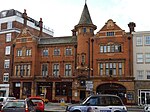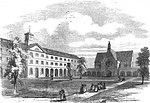Temperance Billiard Hall, Fulham
Commercial buildings completed in 1910FulhamGrade II listed buildings in the London Borough of Hammersmith and FulhamGrade II listed commercial buildingsPub stubs ... and 1 more
Pubs in the London Borough of Hammersmith and Fulham

The Temperance Billiard Hall, now a pub called The Temperance, is a Grade II listed building at 90 Fulham High Street, Fulham, London.It was built in 1910, and the architect was Norman Evans.It was built for a company called Temperance Billiard Halls Ltd, who built a number of such halls in London and the north of England. The temperance movement urged the reduced or prohibited use of alcoholic beverages. It was previously part of the chain O'Neill's, and before that was part of the Firkin Brewery chain and known as the Pharaoh and Firkin.
Excerpt from the Wikipedia article Temperance Billiard Hall, Fulham (License: CC BY-SA 3.0, Authors, Images).Temperance Billiard Hall, Fulham
Fulham High Street, London Parson's Green (London Borough of Hammersmith and Fulham)
Geographical coordinates (GPS) Address Website External links Nearby Places Show on map
Geographical coordinates (GPS)
| Latitude | Longitude |
|---|---|
| N 51.4694 ° | E -0.2105 ° |
Address
The Temperance
Fulham High Street 90
SW6 3LF London, Parson's Green (London Borough of Hammersmith and Fulham)
England, United Kingdom
Open on Google Maps










